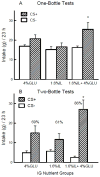Post-oral fat stimulation of intake and conditioned flavor preference in C57BL/6J mice: A concentration-response study
- PMID: 24582671
- PMCID: PMC4046699
- DOI: 10.1016/j.physbeh.2014.02.047
Post-oral fat stimulation of intake and conditioned flavor preference in C57BL/6J mice: A concentration-response study
Abstract
Fat appetite is determined not only by orosensory (flavor) stimuli but also by the post-oral actions of dietary fat, which promote increased attraction to the flavors of high-fat foods. Experiment 1 presents a concentration-response analysis of how intragastric (IG) fat self-infusions stimulate intake and condition flavor preferences in C57BL/6J mice trained 1h/day. Separate groups of food-restricted mice consumed a flavored saccharin solution (the CS-) paired with IG self-infusions of water (Test 0) followed by a different flavored solution (the CS+) paired with IG self-infusions of 1.6, 3.2, 6.4 or 12.8% Intralipid (IL, soybean oil) (Tests 1-3). Following additional CS- and CS+ training sessions, a two-bottle CS+ vs. CS- choice test was conducted without infusions. Infusions of 3.2-12.8% IL stimulated CS+ licking in the first test session and more so in subsequent test sessions, and also conditioned significant CS+ preferences. These effects were similar to those previously observed with isocaloric glucose infusions (8-32%). IG infusion of 1.6% IL stimulated intake slightly but did not condition a CS+ preference comparable to the actions of isocaloric 4% glucose. Experiment 2 compared these subthreshold IL and glucose concentrations with that of a 1.6% IL+4% glucose infusion. This mixture stimulated 1-h CS+ licking more rapidly but generated a preference similar to that of 1.6% IL. In 23h/day tests, however, the IL+glucose mixture stimulated greater CS+ intakes and preferences than did 1.6% IL or 4% glucose. These findings show that fat, like glucose, rapidly generates concentration-dependent post-oral signals that stimulate intake and enhance preferences for energy-rich foods in mice.
Keywords: Appetition; Glucose; Intragastric; Intralipid; Post-oral fat conditioning.
Copyright © 2014 Elsevier Inc. All rights reserved.
Figures






References
-
- Ackroff K, Sclafani A. Flavor preferences conditioned by intragastric infusions of dilute Polycose solutions. Physiol Behav. 1994;55:957–62. - PubMed
-
- Ackroff K, Rozental D, Sclafani A. Ethanol-conditioned flavor preferences compared with sugar- and fat-conditioned preferences in rats. Physiol Behav. 2004;81:699–713. - PubMed
-
- Ackroff K, Lucas F, Sclafani A. Flavor preference conditioning as a function of fat source. Physiol Behav. 2005;85:448–60. - PubMed
Publication types
MeSH terms
Substances
Grants and funding
LinkOut - more resources
Full Text Sources
Other Literature Sources
Medical

